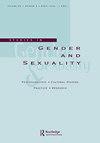Realness With a Twist1: Gender Creativity in the LGBTQ Ballroom
Q3 Social Sciences
引用次数: 1
Abstract
ABSTRACT Based on semistructured interviews with 20 transgender people of color who are active in the New York City LGBTQ (lesbian, gay, bisexual, transgender, questioning) ballroom-house culture, this qualitative study explores the subjective need for recognition of transgender realness against the demonstrable threat of exposure, rejection, and gendered violence. Applying a Winnicottian lens, the ballroom is understood as an intermediary space where gender creativity is celebrated and the subjective meaning of realness is unchallenged between the internal psyche and external, transphobic culture. Using D. W. Winnicott’s concept of the “right not to communicate for fear of being infinitely exploited,” this article considers the “joy in hiding and the disaster in not being found” for people of trans experience who are sought out and exposed, yet not truly recognized or protected. In clinical work, a focus on detecting transgender realness shows up as impingements—deflected by the patient’s compliant object-relating—on what Winnicott calls the “personal core,” thwarting genuine communication, psychic growth, and “all the sense of real.” Lessons from the ballroom-house community illuminate the hard-earned quest for recognition against the demand to unmark transgender realness for trans and gender-diverse (TGD) people of color who navigate explicit and micro violations, including the historical violence of erasure.扭曲的真实:LGBTQ舞厅的性别创造力
摘要本定性研究基于对20名活跃在纽约市LGBTQ(女同性恋、男同性恋、双性恋、跨性别者、质疑)舞厅文化中的有色人种跨性别者的半结构化采访,探讨了在暴露、拒绝和性别暴力的明显威胁下,承认跨性别真实性的主观需求。运用温尼科特式的视角,舞厅被理解为一个中介空间,在这里,性别创造力得到了庆祝,真实性的主观意义在内在心理和外部的跨性别恐惧文化之间不受挑战。使用D。 W 温尼科特的“因害怕被无限利用而不交流的权利”概念,这篇文章认为,对于那些被寻找和暴露但没有得到真正承认或保护的跨性别者来说,“隐藏的快乐和不被发现的灾难”。在临床工作中,对检测跨性别真实性的关注表现为对温尼科特所说的“个人核心”的冲击——被患者顺从的对象所转移——阻碍了真正的沟通、心理成长和“所有真实感”。舞厅的经验教训 社区照亮来之不易的追求 对于 对…的承认 要求揭露跨性别和性别多样性(TGD)有色人种的跨性别真实性,这些有色人种操纵着显性和微观的侵犯行为,包括历史上的抹杀暴力。
本文章由计算机程序翻译,如有差异,请以英文原文为准。
求助全文
约1分钟内获得全文
求助全文
来源期刊

Studies in Gender and Sexuality
Social Sciences-Gender Studies
CiteScore
0.80
自引率
0.00%
发文量
15
期刊介绍:
Beginning in the final two decades of the 20th century, the study of gender and sexuality has been revived from a variety of directions: the traditions of feminist scholarship, postclassical and postmodern psychoanalytic theory, developmental research, and cultural studies have all contributed to renewed fascination with those powerfully formative aspects of subjectivity that fall within the rubric of "gender" and "sexuality." Clinicians, for their part, have returned to gender and sexuality with heightened sensitivity to the role of these constructs in the treatment situation, including the richly variegated ways in which assumptions about gender and sexuality enter into our understandings of "normality" and "pathology."
 求助内容:
求助内容: 应助结果提醒方式:
应助结果提醒方式:


